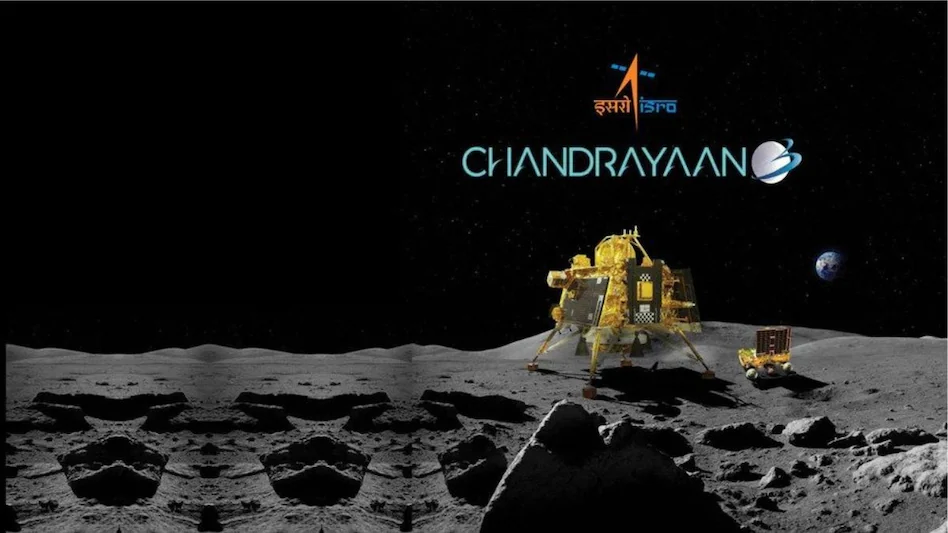The moon, Earth’s celestial neighbour, has always been a subject of fascination for humans. Chandrayaan-3 has inspired countless myths, stories, and scientific endeavours. In recent years, the focus of lunar exploration has shifted to its enigmatic south pole, where India’s Chandrayaan-3 recently made history.
In this article, we’ll delve into the intricacies of Chandrayaan-3’s successful mission, its significance, and the challenges of lunar exploration.
The Lunar Web
The moon’s south pole is a place of stark contrast. It experiences 14 days of continuous sunlight followed by 14 days of complete darkness. The significance of this lies in the extreme conditions it presents for spacecraft like Chandrayaan-3.
The South Pole Challenge
Chandrayaan-3 faced several hurdles due to the lunar south pole’s unique features. This region is replete with craters, imposing rocks, and deep shadows due to the sun’s absence. The presence of ice in these shadows, while scientifically fascinating, adds complexity to lunar exploration.
Communication Challenge
One of the foremost challenges is maintaining communication with Earth during lunar landings. The moon’s curvature and distance create obstacles for radio signals, often leading to lost connections, as seen in previous missions. Chandrayaan-2’s Vikram lander’s contact was lost just 2,100 meters from the lunar surface.

The Quest for Lunar South Pole
But why undertake such perilous missions to the moon’s south pole? The answer lies in the potential benefits for future space endeavours.
Lunar Launchpad
Landing on the moon’s surface requires a tremendous amount of fuel to overcome Earth’s gravity. Rockets rely on boosters that consume vast quantities of fuel in seconds. Establishing a lunar base at the south pole could provide a launchpad with reduced gravity, requiring significantly less fuel for future space missions.
Lunar Resources
The lunar south pole holds promise in terms of resources. Water ice can be used to generate oxygen and hydrogen for rocket fuel, as well as for drinking water. Moreover, helium-3, a rare isotope crucial for nuclear reactors, is believed to be abundant in this region. Its potential for energy generation is immense.
Chandrayaan-3's Success
India’s Chandrayaan-3 achieved a remarkable feat by successfully landing on the lunar south pole, becoming the first country to do so. What sets it apart is not just the accomplishment itself, but the cost-effectiveness of the mission. Compared to Russia’s Luna-25, which crashed with a $200 million investment, Chandrayaan-3 achieved success at just $615 million.
Anatomy of Chandrayaan-3
Chandrayaan-3 comprises three components:
- The propulsion module
- Vikram lander (named after Dr. Vikram Sarabhai)
- The Pragyan rover
The lander, equipped with landing thrusters and advanced instruments, was specially designed for soft landings. Unlike impact landings, soft landings ensure minimal damage to sensitive equipment.
The Journey to the Moon
Chandrayaan-3’s journey to the moon was meticulously planned and executed. It was launched on July 14, 2023, from the Satish Dhawan Space Center using the LVM3 rocket. The spacecraft orbited Earth from July 14 to August 1, gradually increasing its speed using Earth’s gravity to propel it towards the moon.
Lunar Arrival
Upon reaching the moon’s vicinity, Chandrayaan-3 began its descent. On August 23, 2023, with only 30 km left to the lunar surface, the lander initiated its braking system. A 30-second hover allowed for precise landing site selection. Finally, at 6:02 pm, Vikram Lander touched down at the lunar south pole, marking a historic moment.
Chandrayaan-3 Mission:
— ISRO (@isro) August 23, 2023
'India🇮🇳,
I reached my destination
and you too!'
: Chandrayaan-3
Chandrayaan-3 has successfully
soft-landed on the moon 🌖!.
Congratulations, India🇮🇳!#Chandrayaan_3#Ch3
Apollo 11 vs. Chandrayaan-3
A question often raised is why Apollo 11 reached the moon in just three days while Chandrayaan-3 took 40. The answer lies in priorities. Apollo 11 was a crewed mission with the utmost priority of safely delivering astronauts to the moon and back. Chandrayaan-3, being a research mission, prioritized scientific objectives over speed.
Powering Through Darkness
One critical concern during lunar south pole missions is the absence of sunlight for 14 days. Both Vikram Lander and Pragyaan Rover rely on solar energy. During the lunar night, Pragyaan Rover loses contact with ISRO but remains connected to Vikram Lander. The latter acts as a relay, ensuring essential communication.
A Lunar Legacy
While Vikram Lander and Pragyaan Rover won’t return to Earth due to limited fuel, their legacy lives on. However, investigations and findings of both Vikram Lander and Pragyaan Rover will deepen our understanding of the moon and its resources. Chandrayaan-3 has made it possible to explore the moon in the future and has put India at the forefront of space exploration.
Conclusion
In conclusion, the fact that Chandrayaan-3 was able to land safely in the south pole of the moon is a tribute to human ingenuity and the spirit of discovery. It represents a significant advancement in lunar exploration as well as India’s scientific capabilities. Future-facing spacecraft Chandrayaan-3 is showing us the way as humans continue to be drawn to the moon’s wonders.
Frequantly Asked Questions (FAQs)
Why is the lunar south pole significant for space exploration? The lunar south pole offers reduced gravity, potential resources like water ice and helium-3, and serves as a strategic launchpad for future space missions.
What distinguishes soft landings from impact landings on the moon? Soft landings involve precise control of thrusters to gently touch down on the lunar surface, minimizing damage to equipment, while impact landings involve a controlled crash.
What is the purpose of Pragyaan Rover on Chandrayaan-3? Pragyaan Rover is designed to conduct on-site experiments and collect samples on the lunar surface, contributing to scientific research.
How will Chandrayaan-3’s findings benefit future lunar exploration? Chandrayaan-3’s research and discoveries will aid in understanding lunar resources and conditions, making future lunar missions more efficient and effective.


1 thought on “Chandrayaan-3: Successful Mission, Significance, Challenges”